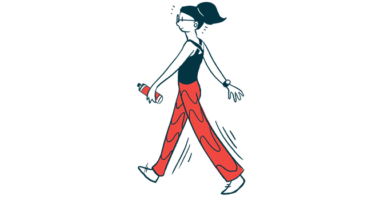High Androgen Levels in Cushing’s Women Linked to 11oxC19 Steroids
Such hyperandrogenemia in patients can lead to menstrual problems, acne

11oxC19 steroids, which are part of the androgen family of male sex hormones, are the primary drivers of hyperandrogenemia in women with Cushing’s disease, a study has found.
Hyperandrogenemia, or high levels of androgens, in women with Cushing’s can lead to menstrual problems, acne, excessive body hair, and temporary hair loss. The data also showed that the approved therapy Isturisa (osilodrostat) may treat the clinical signs and symptoms of hyperandrogenism.
Researchers noted that larger studies are needed to determine in more detail the role of 11oxC19 steroids in Cushing’s.
The study, “11-Oxygenated C19 steroids are the predominant androgens responsible for hyperandrogenemia in Cushing’s disease,” was published in the European Journal of Endocrinology.
Cushing’s disease occurs when non-cancerous tumors form in the brain’s pituitary gland, leading to the excessive production of adrenocorticotropic hormone (ACTH). Elevated levels of this hormone signal the adrenal glands, which sit atop the kidneys, to overproduce cortisol.
Surgically removing these tumors through a procedure called transsphenoidal adenomectomy is considered the first-line treatment for Cushing’s.
High androgen levels in women
Notably, however, ACTH stimulation also leads to the excessive production and release of androgens — a group of hormones mainly associated with male sexual development, including testosterone, dihydrotestosterone, and androstenedione.
When hyperandrogenemia occurs in women with Cushing’s, it can lead to a series of problems, including menstrual irregularities, excessive hair growth, known as hirsutism, and acne. But measured levels of common androgens do not correlate with hyperandrogenemia symptoms.
11-oxygenated C19 steroids (11oxC19) are less known members of the androgen family, and include 11-ketotestosterone (11KT), 11-ketodihydrotestosterone (11KDHT), and 11-beta-hydroxyandrostenedione (11OHA4). Both 11KT and 11KDHT have been shown to be as potent as testosterone and dihydrotestosterone, respectively.
Moreover, the production of 11oxC19 steroids requires 11-beta-hydroxylase, an enzyme found in the adrenal glands that is stimulated by ACTH.
Building on these findings, researchers in Germany and the U.K. hypothesized that 11oxC19 steroids are the main drivers of hyperandrogenemia symptoms in women with Cushing’s disease.
To test this hypothesis, the team collected saliva and urine samples from 36 women with Cushing’s. The samples from 23 were taken before they underwent transsphenoidal surgery — making this group “treatment-naïve.” The other 13 women had samples taken after successfully undergoing the procedure.
Ten other women with Cushing’s who failed to respond to surgery and were treated with Metopirone (metyrapone) and Isturisa — five on each medication — also were included in the analyses. A group of 26 healthy women also was added as a control cohort, for comparison.
Saliva samples collected over the course of one day were tested for cortisol, cortisone, testosterone, androstenedione, 11KT, and 11OHA4. Metabolites of common and 11-oxygenated androgens in 24-hour urine also were analyzed.
Both concentrations of 11KT and 11OHA4 were clearly elevated throughout the day in treatment-naïve patients compared with controls. Treatment-naïve patients also showed an unusual nighttime increase in 11oxC19 levels.
In contrast, testosterone and androstenedione were not significantly different in the two groups.
Among the 23 patients with treatment-naïve Cushing’s, six showed no hyperandrogenic symptoms. Six had one sign, and another six had two. There were four patients with three symptoms, and one with four. Although more hyperandrogenism symptoms were seen in patients with higher levels of 11oxC19 steroids, this trend was not considered statistically significant.
Elevated salivary cortisol was found to correlate significantly with higher levels of 11OHA4, androstenedione, and ACTH, but not with 11KT, testosterone, and other sex-related hormones. Blood cortisol also was correlated with 11OHA4.
After surgery
Salivary profile analyses revealed a marked reduction of 11KT and 11OHA4 concentrations after surgery, but no significant reductions in testosterone and androstenedione levels. This elevation of 11oxC19 steroids before surgery and the significant decrease after surgery correlated with the post-surgical reduction in ACTH, which was confirmed in the urinary analysis.
11oxC19 concentrations were normalized with equal efficacy by Metopirone and Isturisa, the data showed.
The median 11KT level in treatment-naïve patients was 853.2 picomoles per liter (pmol/L) versus 251.0 pmol/L after Metopirone, and 261.5 pmol/L after Isturisa. Likewise, the median 11OHA4 level in treatment-naïve patients was 2,484.0 pmol/L, versus 461.5 with Metopirone and 492.0 with Isturisa.
Among patients treated with Metopirone, but not Isturisa, classical androgen levels, especially androstenedione, were markedly elevated throughout the day compared with controls and treatment-naïve patients. This result suggests that Isturisa reduced androgen concentrations more effectively than Metopirone, the researchers noted.
“Our data show that ACTH-mediated 11oxC19 steroids represent the predominant active androgens causing hyperandrogenemia in [Cushing’s disease],” the researchers wrote. “Our data also indicate that [Isturisa] might be a more suitable [steroid blocker] for [Cushing’s disease] patients with clinical signs of hyperandrogenism.”
Researchers also added that “studies in larger cohorts are needed to study the role of 11oxC19 in [Cushing’s disease] in more detail.”








